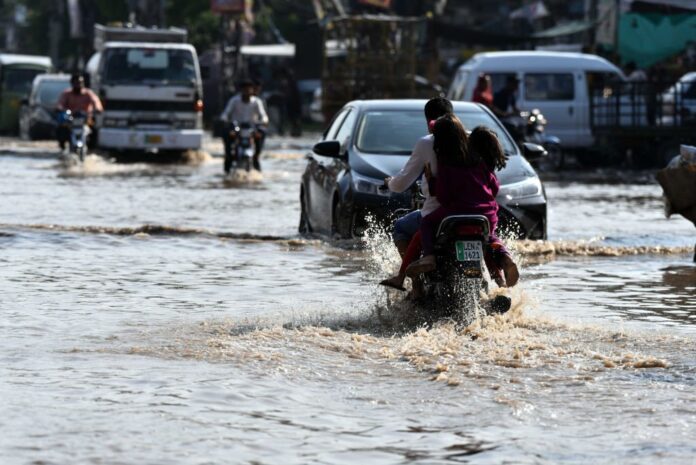LAHORE: The latest monsoon spell made a grand entrance over the weekend, showering several cities in Punjab, including Lahore, with refreshing rain and dropping temperatures to the delight of the populace.
In Bhakkar, Kasur, and nearby regions, the weather took a pleasant turn as the rain brought down the mercury considerably.
Meanwhile, in Lahore, the downpour varied from light to heavy in different areas, drenching locations such as Abbot Road, Davis Road, Lakshmi Chowk, Mall Road, Shimla Pahari, Data Darbar, Gulshan Ravi, Johar Town, Gulberg, Samanabad, Baghbanpura, Garhi Shahu, and Burki.
While the rain was indeed a welcome change, it also resulted in water accumulation on various roads, causing disruptions to traffic flow. Low-lying areas in Lahore, Kasur, and other cities found themselves inundated, and power outages affected several regions.
The temperature recordings from some major cities on Saturday morning included Islamabad and Quetta at 26 degrees Celsius, Lahore and Peshawar at 29 degrees Celsius, Karachi at 30 degrees Celsius, Gilgit at 22 degrees Celsius, Murree at 18 degrees Celsius, and Muzaffarabad at 25 degrees Celsius.
The Meteorological Department has predicted that monsoon currents will continue to penetrate the country from the Bay of Bengal.
Additionally, a westerly trough is affecting the upper parts of the country and is likely to persist over the next few days.
From July 22 to 26, Kashmir, Gilgit-Baltistan, Murree, Galliyat, Islamabad, Rawalpindi, and several other cities are likely to experience rain, wind-thundershowers, and occasional heavy falls.
These regions include (but are not limited to) Neelum Valley, Muzaffarabad, Poonch, Hattian, Bagh, Haveli, Sudhanoti, Kotli, Bhimber, Mirpur, Diamir, Astore, Ghizer, Skardu, Hunza, Ghanche, Shigar, Attock, Chakwal, Jhelum, Mandi Bahauddin, Sialkot, Narowal, Lahore, Sheikhupura, Hafizabad, Gujranwala, Gujrat, Kasur, Mianwali, Sargodha, Khushab, Faisalabad, Toba Tek Singh, Jhang, Sahiwal, Bahawalnagar, Okara, Chitral, Dir, Swat, Shangla, Buner, Mansehra, Kohistan, Abbottabad, Haripur, Peshawar, Mardan, Swabi, Nowshera, Kurram, Lakki Marwat, Kohat, Dera Ismail Khan, Bannu, Karak, and Waziristan.
From July 22 to 24, Zhob, Sherani, Barkhan, Musakhel, Kohlu, Naseerabad, Jhal Magsi, Loralai, Ziarat, Mastung, Kalat, Khuzdar, Lasbella, Awaran, Kech, Panjgur, Dera Ghazi Khan, Rajanpur, Multan, Khanewal, Bhakkar, Layyah, Kot Addu, Bahawalpur, Rahim Yar Khan, Tharparkar, Umerkot, Mirpurkhas, Sukkur, Larkana, Jacobabad, Dadu, Shaheed Benazirabad, Hyderabad, Sanghar, Badin, Thatta, and Karachi may also experience rain, wind-thundershowers, and isolated heavy falls, albeit with occasional breaks.
Due to heavy rains, urban flooding may occur in low-lying areas of Islamabad, Rawalpindi, Peshawar, and Lahore between July 22 and 26. Additionally, there is a risk of landslides in vulnerable areas such as Murree, Galliyat, Kashmir, Gilgit-Baltistan, and hilly regions of Khyber Pakhtunkhwa during this period.
Flash flooding is a concern for Kashmir, Dir, Swat, Kohistan, Shangla, Buner, Manshera, Abbottabad, and Rawalpindi/Islamabad between July 22 and 26. The hill torrent of Dera Ghazi Khan and adjacent areas of northeast Balochistan may also experience heavy rains and potential flooding on July 22 and 23.
Furthermore, water logging could affect low-lying areas of Karachi and Hyderabad from July 22 to 24.
In light of these weather forecasts, it is essential for residents in the affected regions to take necessary precautions to safeguard life and property during this monsoon spell.






















